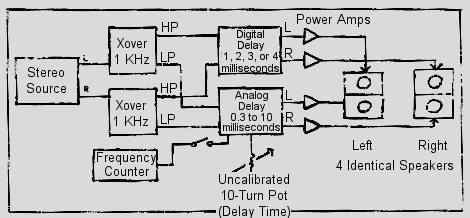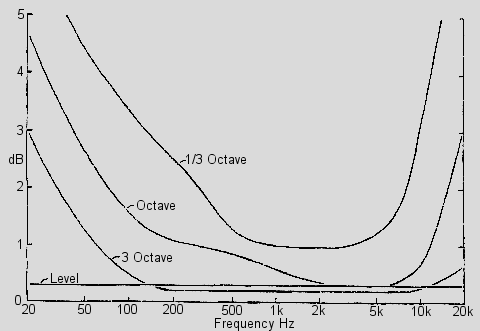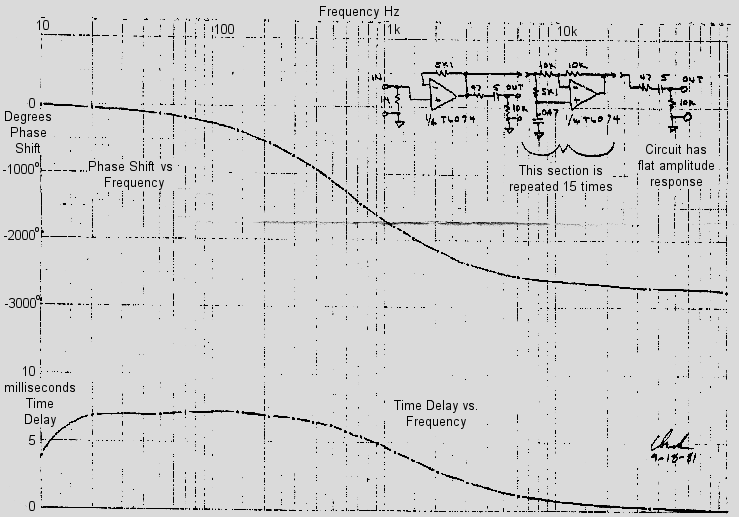- Joined
- Jan 14, 2011
- Messages
- 74,961
- Location
- Gillette, Wyo.
- Tagline
- Halfbiass...Electron Herder and Backass Woof
Interesting article......
On and off for the past couple of years I have been experimenting with the effects of intentional time and frequency response aberrations. My experiments have perhaps been unique in that they have been performed using normal home or control room environments with hearing constituting the instrumentation. The hearing could truly be called instrumentation because listening was done double-blind and opinions were not used. Listeners were simply asked to perform a task or to hear a difference. I feel that studies of this type are more relevant to knowledge of sound reproduction than clinical tests or opinions derived from "open" evaluations.
For the sake of clarity and simplicity, I will describe the experiments as though they proceeded orderly as if following some master plan. The experiments in reality took many "dead end" paths and were guided by hunches, finances, time, and available equipment. I often wonder if experiments that seem to have been perfectly orchestrated from the beginning might not have followed up a hunch that would have led to even more interesting results.
SPEAKER ALIGNMENT AUDIBILITY
The purpose of the first experiment was to determine people's ability to hear time offset of a woofer and tweeter. The test setup is shown in Figure 1. Left and right channels were treated identically. The signal from either channel first is divided into high-pass and low-pass by a 6 dB / octave unity sum crossover at 1 KHz. A high quality crystal time base digital time delay unit with delay either 1, 2, 3, or 4 milliseconds is inserted in the high-pass path. An analog time delay unit with delay adjustable via an uncalibrated 10-turn control from 0.3 to 10 milliseconds is inserted in the low-pass path. The high- and low-pass signals are then amplified and fed to two identical stacked full range speakers (Phillips AD5061s). Thus in the full stereo system we have four identical speakers. Each side has the lower speaker assigned to be the woofer and the upper assigned to be the tweeter.
[TABLE]
[TR]
[TD]
 [/TD]
[/TD]
[/TR]
[TR]
[TD]Figure 1: Experimental setup to determine listener's ability to match time delays. Listener has adjusted the uncalibrated pot for "most natural blend" of woofer and tweeter.[/TD]
[/TR]
[/TABLE]
Using music of the listener's choice, the listener is asked to find the setting of the 10-turn control which produces the most natural blend of woofer and tweeter. Technically, the task is to match the acoustic position of the woofer and tweeter by matching the time delays.
Since the listener does not know the setting of the digital delay or the relationship between the analog unit's control rotation and its delay, (it is quite non-linear), the only clue to proper alignment is sound. (The knob was even loosened from the shaft and rotated between trials.) Since no one knows the correct setting in advance the experiment is double-blind. After the listener is satisfied with the setting, a frequency counter is connected to measure the clock frequency of the analog delay. From this the actual delay is calculated.
Despite the possibility of "digital effects," the modest quality of the speakers, and the fact that the listeners were in effect being tested, every one of approximately 12 participants was able to match the time delays to within +/- 40 microseconds (about 1/2 inch). This finding confirms the clams of those who espouse the virtues of arrival time compensated loudspeakers.
After testing the listeners were asked how they found the correct setting. In general, the replies were that for extreme settings of the control, the sound would come from either the woofer or tweeter speaker. Somewhere in the transition range a "swooshing" or "phasing" effect was heard. The final position of the control was the one that "tuned out" the phasing or swooshing.
Other than the obvious implication of the Haas effect for extreme settings, no one spoke of sensing "time smear" or any quality except the swooshing which could be considered to be either a time or frequency response effect. Since a time offset would obviously cause comb filtering over a wide range due to the 6 dB / octave crossover, I was curious to know if it was time or frequency response that was responsible for the listeners' ability to align the speakers in the experiment.
FREQUENCY RESPONSE AUDIBILITY
Figure 2 is a graph of various bandwidths of minimum phase response aberrations or level mismatches which have proven to be just inaudible in double-blind testing. For most of this data the subject was myself. Spot checks showed that I am fairly typical in my ability, but additional testing would only serve to lower these curves. As they stand, they indicate that very small ripples in the frequency response such as those generated by a slight time offset could be audible. The on-axis frequency response could also change because of the vertical polar pattern shifts resulting from time delay combined with the vertical displacement of the drivers in the test. Lastly, the act of tuning to an upper swoosh threshold then down to the lower swoosh threshold then finally centering the knob between the extremes could result in enhanced "setability." In summary, frequency response effects alone could account for the remarkable ability to match acoustic centers.
[TABLE]
[TR]
[TD]
 [/TD]
[/TD]
[/TR]
[TR]
[TD]Figure 2: Amplitude of the frequency response matching errors of various bandwidths which should [/TD]
[/TR]
[/TABLE]
[TABLE]
[TR]
[TD]www.ethanwiner.com - since 1997[/TD]
[/TR]
[TR]
[TD]
[/TR]
[/TABLE]
[TR]
[TD]www.ethanwiner.com - since 1997[/TD]
[/TR]
[TR]
[TD]
[TABLE]
[TR]
[TD]Home & Contact[/TD]
[TD]Audio & Music Bio[/TD]
[TD]Programming[/TD]
[TD]Wisdoms & Quotes[/TD]
[TD]Funny Names[/TD]
[/TR]
[TR]
[TD]Magazine Articles[/TD]
[TD]Cello Page[/TD]
[TD]Ethan's Tunes[/TD]
[TD]Oxymorons[/TD]
[TD]Family Photos[/TD]
[/TR]
[/TABLE]
[/TD][TR]
[TD]Home & Contact[/TD]
[TD]Audio & Music Bio[/TD]
[TD]Programming[/TD]
[TD]Wisdoms & Quotes[/TD]
[TD]Funny Names[/TD]
[/TR]
[TR]
[TD]Magazine Articles[/TD]
[TD]Cello Page[/TD]
[TD]Ethan's Tunes[/TD]
[TD]Oxymorons[/TD]
[TD]Family Photos[/TD]
[/TR]
[/TABLE]
[/TR]
[/TABLE]
Some Experiments With Time
On the audibility of phase shiftby David Clark[TABLE="width: 70%"]
[TR]
[TD]This article was written by David Clark in 1981 for the Winter 1983 issue of the Syn-Aud-Con newsletter. It is reprinted here with David's kind permission because I believe it is still very relevant today.[/TD]
[/TR]
[/TABLE]
[HR][/HR][Syn-Aud-Con newsletter] Editor's Note: David L. Clark, manufacturer of the ABX Comparator, has taken the leap into a "highly charged" area. We admire his thoroughness and are pleased to publish his comments on the subject. Both David and Syn-Aud-Con would be tremendously pleased to hear any comments Syn-Aud-Con graduates have to offer. In the meantime, we appreciate David's having fired the opening gun.[TR]
[TD]This article was written by David Clark in 1981 for the Winter 1983 issue of the Syn-Aud-Con newsletter. It is reprinted here with David's kind permission because I believe it is still very relevant today.[/TD]
[/TR]
[/TABLE]
[TABLE="width: 70%"]
[TR]
[TD]Three experiments were performed which confirm the audibility of time offset in loudspeaker drivers but indicate that this audibility is due only to the frequency response aberrations resulting from the time offset. Implications of these results are discussed.[/TD]
[/TR]
[/TABLE]
INTRODUCTION[TR]
[TD]Three experiments were performed which confirm the audibility of time offset in loudspeaker drivers but indicate that this audibility is due only to the frequency response aberrations resulting from the time offset. Implications of these results are discussed.[/TD]
[/TR]
[/TABLE]
On and off for the past couple of years I have been experimenting with the effects of intentional time and frequency response aberrations. My experiments have perhaps been unique in that they have been performed using normal home or control room environments with hearing constituting the instrumentation. The hearing could truly be called instrumentation because listening was done double-blind and opinions were not used. Listeners were simply asked to perform a task or to hear a difference. I feel that studies of this type are more relevant to knowledge of sound reproduction than clinical tests or opinions derived from "open" evaluations.
For the sake of clarity and simplicity, I will describe the experiments as though they proceeded orderly as if following some master plan. The experiments in reality took many "dead end" paths and were guided by hunches, finances, time, and available equipment. I often wonder if experiments that seem to have been perfectly orchestrated from the beginning might not have followed up a hunch that would have led to even more interesting results.
SPEAKER ALIGNMENT AUDIBILITY
The purpose of the first experiment was to determine people's ability to hear time offset of a woofer and tweeter. The test setup is shown in Figure 1. Left and right channels were treated identically. The signal from either channel first is divided into high-pass and low-pass by a 6 dB / octave unity sum crossover at 1 KHz. A high quality crystal time base digital time delay unit with delay either 1, 2, 3, or 4 milliseconds is inserted in the high-pass path. An analog time delay unit with delay adjustable via an uncalibrated 10-turn control from 0.3 to 10 milliseconds is inserted in the low-pass path. The high- and low-pass signals are then amplified and fed to two identical stacked full range speakers (Phillips AD5061s). Thus in the full stereo system we have four identical speakers. Each side has the lower speaker assigned to be the woofer and the upper assigned to be the tweeter.
[TABLE]
[TR]
[TD]

[/TR]
[TR]
[TD]Figure 1: Experimental setup to determine listener's ability to match time delays. Listener has adjusted the uncalibrated pot for "most natural blend" of woofer and tweeter.[/TD]
[/TR]
[/TABLE]
Using music of the listener's choice, the listener is asked to find the setting of the 10-turn control which produces the most natural blend of woofer and tweeter. Technically, the task is to match the acoustic position of the woofer and tweeter by matching the time delays.
Since the listener does not know the setting of the digital delay or the relationship between the analog unit's control rotation and its delay, (it is quite non-linear), the only clue to proper alignment is sound. (The knob was even loosened from the shaft and rotated between trials.) Since no one knows the correct setting in advance the experiment is double-blind. After the listener is satisfied with the setting, a frequency counter is connected to measure the clock frequency of the analog delay. From this the actual delay is calculated.
Despite the possibility of "digital effects," the modest quality of the speakers, and the fact that the listeners were in effect being tested, every one of approximately 12 participants was able to match the time delays to within +/- 40 microseconds (about 1/2 inch). This finding confirms the clams of those who espouse the virtues of arrival time compensated loudspeakers.
After testing the listeners were asked how they found the correct setting. In general, the replies were that for extreme settings of the control, the sound would come from either the woofer or tweeter speaker. Somewhere in the transition range a "swooshing" or "phasing" effect was heard. The final position of the control was the one that "tuned out" the phasing or swooshing.
Other than the obvious implication of the Haas effect for extreme settings, no one spoke of sensing "time smear" or any quality except the swooshing which could be considered to be either a time or frequency response effect. Since a time offset would obviously cause comb filtering over a wide range due to the 6 dB / octave crossover, I was curious to know if it was time or frequency response that was responsible for the listeners' ability to align the speakers in the experiment.
FREQUENCY RESPONSE AUDIBILITY
Figure 2 is a graph of various bandwidths of minimum phase response aberrations or level mismatches which have proven to be just inaudible in double-blind testing. For most of this data the subject was myself. Spot checks showed that I am fairly typical in my ability, but additional testing would only serve to lower these curves. As they stand, they indicate that very small ripples in the frequency response such as those generated by a slight time offset could be audible. The on-axis frequency response could also change because of the vertical polar pattern shifts resulting from time delay combined with the vertical displacement of the drivers in the test. Lastly, the act of tuning to an upper swoosh threshold then down to the lower swoosh threshold then finally centering the knob between the extremes could result in enhanced "setability." In summary, frequency response effects alone could account for the remarkable ability to match acoustic centers.
[TABLE]
[TR]
[TD]

[/TR]
[TR]
[TD]Figure 2: Amplitude of the frequency response matching errors of various bandwidths which should [/TD]
[/TR]
[/TABLE]


